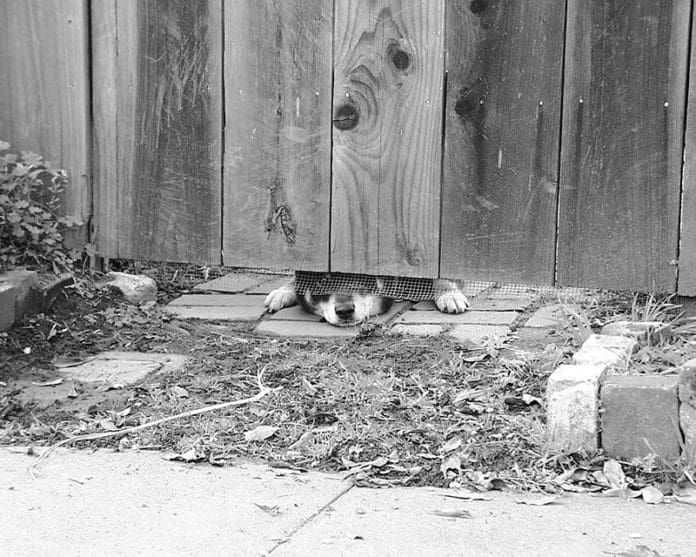FENCE AGGRESSION: OVERVIEW
1. If your dog is just beginning to display barrier frustration, take steps immediately to eliminate his opportunities to practice the behavior. The more opportunities he has to practice the behavior, the more difficult it will be to control it.
2. Build a solid fence to prevent your dog from being able to see the things that arouse him and trigger his barking. If you already have a solid fence, keep him in the house unless you are supervising him.
3. Counter-condition your dog to the stimulus that sets him off. If bikes trigger his fence-running and barking, sit in the yard with him and toss delicious treats to him as a helpful friend on a bike approaches and passes by.
As I sit here writing, I hear a ruckus from my backyard. Leaning forward, I look out my window to see Dubhy the Scottie running the fenceline and barking madly at two black Labs who have wandered over from a distant neighbor’s house, still sporting the highly ineffective shock collars that are supposed to keep them home.
As I cuss under my breath yet again at my irresponsible neighbors and get up to call Dubhy in, I have a sudden epiphany. Three years ago when Dubhy’s on-again, off-again dog aggression erupted for the first time, it was directed at a black Lab. I have always wondered why . . . and suddenly I see it. There’s a good chance that Dubhy has a strong negative classical association with black Labrador Retrievers as a result of his irregular but frequent encounters-of-the-fence-kind with our neighbor’s wayward dogs. Duh!

In his famous poem, “Mending Wall,” Robert Frost starts out by saying, “Something there is that doesn’t love a wall.” We could revise that slightly to say “Something there is that doesn’t love a fence.”
That “something” is our dogs.
Fence-running, and its close cousin, fence-fighting, are manifestations of barrier frustration, also called restraint frustration. The frustration that a dog feels when he can see – but not reach – his objective can (and often does) give rise to canine obsessive-compulsive disorders (COCD) and aggression, both of which are serious behavior problems caused by stress.
Fence-running can quickly become a COCD. I see a mild version of it with Dubhy – stereotypic running along the fence line, accompanied by aroused barking, and spinning at the corners. He has a path worn around the interior of our large yard, which wasn’t there prior to his joining our family.
I have no doubt that if Dubhy were a (shudder) backyard dog, he would have serious problems. Instead, he’s only outdoors when we are home, and if he starts his fence-running behavior we interrupt it and bring him in. We are fortunate that our fence doesn’t conjoin any of our neighbors’ fenced-in dogs, or we would have to take much stronger steps to manage or retrain the behavior.
Restraint frustration also quickly turns into aggression. Aggression is caused by anxiety and stress, easily triggered by the arousal of fence-running. Some dogs who fence fight are fine if they meet the same dog sans barrier. Others, like Dubhy, may generalize their aggression to some or all dogs even when there’s no fence present.
As dog owners become more and more responsible about keeping their dogs safe at home, the incidence of fence-related behavior problems rises. Even the unfortunately popular underground electronic (shock) containment system fences can give rise to the problem. The barrier is there, even if the dog can’t see it, and the intense punishment of the shock the dog receives if he breaches the invisible barrier can intensify the resulting aggression.
Tying a dog outside also poses restraint frustration problem, and shares a drawback with electronic fences: neither prevents trespassers (human or otherwise) from invading the dog’s territory, putting both the trespasser and the dog at serious risk.
Preventing Fence Aggression and Barrier Frustration
It sounds like you’re damned if you do, and damned if you don’t! If not confining your dog isn’t safe or responsible, and confining him causes behavior problems, what are you supposed to do with him?
This is a case where prevention and management are much easier solutions than training. There are a number of things you can do to reduce the likelihood and opportunity for fence running and fighting. You can:
1. Install a solid fence
This is the best solution, albeit expensive, and in an increasing number of shortsighted communities, prohibited. If you block your dog’s visual access to the stimuli outside his fences, he’s not likely to get aroused enough to begin the undesirable behaviors. If you live in a no-fence community, you might want to consider moving.
2. Keep your dog indoors
Dogs who are permanent outdoor residents are at high risk for fence-related behavior problems. There are many reasons it’s not wise to leave your dog outdoors when you’re not home; this is just one of them. If he’s out while you’re away, he’ll get lots of opportunities to practice fence-running and -fighting. The more he practices, the harder the behavior is to modify.
Do like we do with Dubhy: let your dog out in the yard for limited periods only when you’re home, and bring him in immediately if he starts the unwanted behaviors.
3. Eliminate the stimuli
Dubhy’s fence problems are triggered by stray dogs and itinerant cats. We eliminated the majority of Dubhy’s fence running by adopting (with the neighbor’s blessing) the neighbor’s cat who had taken up residence in our barn. We had Barney vaccinated and neutered, and brought him indoors, solving a good percentage of Dubhy’s problem. (See “Barney Morphs Into Housie,” next page.) We’re still working on the black Labs.
4. Modify your existing fence
If you have a see-through fence, like the ubiquitous chain-link enclosures common here in Tennessee, do something to make it more solid. There are slats available that you can slide into the chain link to block some of the visual stimuli. This will work with mild fence problems, but won’t deter a dedicated fence-runner or -fighter if he can still see through the gaps between the slats.
You can try the slats to see if they work, and if not, line the inside of the fence with something to block his view completely. FRP (fiberglass reinforced plastic) is probably the most durable option, also the most expensive and least visually offensive. Other options might be plywood, or tarps, at least temporarily.
5. Install an “airlock,” another fairly costly option that can discourage fence-fighting
An airlock is created by building a second fence inside your existing one to create a “no-dog’s land” between your dog and your neighbor’s.
As an added benefit, this protects your dog from neighbor children sticking fingers and potentially harmful objects through the fence. While a double barrier can reduce actual fence-fighting, I am confident that this option would not have put a dent in Dubhy’s fence-running behavior.
Retraining a Fence-Aggressive Dog
If you have a dog who already manifests fence-related behaviors, you can do some training that will help you get a handle on the problem. You have probably already discovered how difficult it can be to call your dog to you when he is in a state of high arousal, racing along the fence in futile, frustrating pursuit of his adversary.
Your first challenge is to find a way through the fog in his brain so he can even acknowledge your presence. With Dubhy, I found that standing directly in his path didn’t work. He simply darted around me and continued on his mission. I know better than to try the lunge-and-grab method, which would only serve to make him wary of me. Tossing something like a treat or a ball to try to break his focus was equally ineffective.
I began a two-pronged training program, one to counter-condition him to the presence of the arousal-causing stimuli, and the other to improve his recall response, even in the face of high distractions.
Recall Training and Counter-Conditioning
The recall training was easiest to implement, as I could do it any place, any time. Dubhy already had a rock-solid and speedy recall in the training center, but it was somewhat less reliable in the backyard, and even less so in wide open spaces. I was already fed up with his “maybe” recall, after being forced on several occasions to go out and get him in the dark when he declined to come back indoors after the pack’s bedtime bathroom break.
We embarked on backyard and long line recall training. Several times a day I would play with Dubhy in the backyard, calling him, giving him a high-value reward (such as canned chicken or fish), and letting him go again. Especially since Dubhy prefers outdoors to indoors – the first dog I have ever had who exhibited this bizarre preference – I didn’t want his recall to be a predictor of “outdoors is over” by bringing him indoors every time I called him.
I would also call him to the back deck and cue him to do several of his tricks for high value rewards, since he likes to do tricks. And I called him and had him do several pieces of agility equipment; he loves his agility stuff. Gradually his recall responses improved.
I even used a little negative punishment on one occasion, when he failed to come for dinner call. Rather than trekking out to get him, I let him stay out, and didn’t serve him his meal when he finally did deign to come in. He hasn’t missed dinner call since.
In addition, we worked on recalls in wide open spaces on his long line, until I started getting snappy responses, even spinning on his heels if he was heading in the other direction. We now take a chance on our five acres and occasionally let him off-leash to practice recalls outside the yard. Most of the time, he comes when called. Every once in a while his Scottie brain takes over, and I have to retrieve him before he wanders off the property.
I also did counter-conditioning work with him. Whenever the opportunity presented itself – with the neighbor dogs or Barney – I went out in the yard and waited for a brief lapse in Dubhy’s fence-focused attention, then offered him yummy treats. At first he would grab a treat and go right back to his running and barking. My ability to keep him focused on me and the treats was in direct proportion to the distance to the stimulus. If the neighbor dogs appeared to be just passing through, Dubhy would stay more attentive to me as they moved away. Over time, as we worked on it, he would turn his attention to me and keep it there with the dogs in closer and closer proximity.
Barney, who loved to tease Dubhy by rolling around on the driveway six feet from the fenceline, was more of a challenge. But with time and practice, I could even call Dubhy away from his feline nemesis.
A Cure for Canine Fence Aggression?
What I have accomplished with Dubhy is a compromise, not a cure. He still “goes off” when neighbor dogs pass by; it’s just easier for me to interrupt his behavior and call him into the house. If I were to leave him in the backyard unattended he would continue his arousal behavior and the COCD nature of his actions, especially the spinning, would probably worsen.
I’m still dealing with the collateral damage of his fence behaviors; specifically, his aggression toward some dogs, especially black Labs. When we are out in the world and he sees another dog he will go on alert – tail up, ears pricked, eyes bright, leaning forward. Then, unless it’s a Lab, he’ll swivel his head toward me to ask for his treat – the positive result of lots of counter-conditioning. With Labs, I still have to draw his attention to me; he doesn’t offer it on his own. I can gauge how aroused or relaxed he is by the amount of pressure from his teeth when he takes the treat from my fingers. With Labs, his teeth definitely hurt.
It would be a very large challenge to counter-condition a dogs’ fence-running or -fighting behaviors to the point that the behavior goes away. Even if you succeed in habituating your dog to the presence of the arousal-causing stimuli, the chances of spontaneous recovery are very high; the behavior is likely to resurrect itself with additional exposures to the stimuli.
Prevention is your best course of action, by not putting your dog in a position to develop the behaviors in the first place – not leaving him fenced and unattended. If it’s too late for prevention, management is your next best bet – putting up a solid fence and/or not leaving in him the yard alone.
If at any time you feel that you and your dog are not making progress, or your dog is exhibiting signs of a serious COCD, contact a good positive behavior consultant or veterinary behavorist. She can evaluate your training and help you investigate the possibility of using behavior modification drugs to control obsessive behaviors that may be interfering with the success of your program.
The property we are hoping to purchase in Maryland is in the middle of 80 rural acres, and the backyard is fenced with a solid wooden fence. Sounds like a great management plan to me!
Robert Frost’s neighbor was right; good fences do make good neighbors, and especially better neighbor dogs!
A Challenge for a Former Cat-Chaser: “Barney” Morphs Into “Housie”
Although my husband and l are strong advocates of indoor-only cats, after we adopted Barney it was our intention to allow him to continue his life as a barn cat until we moved. and then transition him into the house. It can be difficult to turn a full-time outdoor cat into a house resident, and we were reluctant to upset the equilibrium of our four-legged family while we were trying to sell the house. Stressed dogs and cats can find ways to make a house less marketable, if you know what I mean.
Barney, however, had other ideas. On a frigid rainy night just after Christmas, Barney sat outside our den windows and cried for an hour. Clearly, he wanted to come in. I tried to ignore him, but when he took to hanging on the window screens and meowing, I couldn‘t stand it. Barney came indoors.
One of the things that worried me about bringing him in was Dubhy’s reaction. The feisty Scottie had developed a strong animosity toward Labs as a result of his fence running: would he generalize the same reaction to an indoor Barney? I had done scads of counter-conditioning with Dubhy when I brought home a kitten 18 months prior; would that help?
Armed with stick cheese, I let Duhhy into the den with Barney. As I’d feared, Duhhy’s radar was instantly on high alert. His tail went up, ears pricked, eyes bright, leaning forward…l held my breath – and he swiveled his head back toward me for his treat. The crisis was over. Counter-conditioning wins again.
Interestingly enough. Barney’s life as an outdoor cat made him fairly pugnacious. If a dog gives him a hard time, Barney holds his own – lunging at the dog and swatting with claws that are now kept clipped. Barney and Dubhy have invented a game that they play together. Dubhy will tease Barney into leaping at him, and then do puppy rushes around the dining room table, occasionally deliberately passing close enough to Barney to elicit
another lunge. They both seem to derive great enjoyment from the game.
And I was worried.
Pat Miller, WDJ’s Training Editor, is a Certified Pet Dog Trainer, and past president of the Board of Directors of the Association of Pet Dog Trainers. She is also the author of The Power of Positive Dog Training and Positive Perspectives: Love Your Dog, Train Your Dog.







I have a big dog I got at eight weeks. At about nine months, he became fixated on the neighbor’s dog, about the same age, and became a fence fighter. There was a wood fence between the properties and both dogs would body slam it. I did everything in my power to stop it, but it continued no matter what I did. The only time I let him out was to relieve himself and it never failed the neighbor dog would be out in the yard or sometimes quietly laying by the fence waiting on my dog to come out. If he wasn’t by the fence, once he’d hear my door open, you could hear him charging towards fenceline. Then the uproar would start all over again. I got all the blame for the commotion. My neighbor wasn’t willing to work with me to help remedy the problem. She said it was all my fault. All she did was holler and call animal control. Eventually I had to move because I couldn’t tolerate it anymore. After that, my biggest worry was to move next door to someone else with a dog mine might want to challenge again. So I moved to a rural area with much more open space. It’s been peaceful so far. After two years living here, I decided to buy another house with a huge yard in the same rural town. Yesterday I found out the neighbor I am moving next door to has a large dog too. My anxiety kicked in immediately and all the excitement of moving to a new house has turned to dread. I feel sick and trapped. The last thing I want is to have to give up my dog. This could be another nightmare. I haven’t moved in yet, but in two weeks I will. I sure hope I can handle it this time.
Pat, thank you for an excellent article. Since moving to our home 2 years ago, my dog’s behavior towards other dogs on leash has gotten worse. Yesterday as I was about to put him in the car, he saw the neighbors dogs on a walk and ran and got in a scuffle with them. I hadn’t thought about the multiple times he was rushing out to the fence during the day to bark and how this might be increasing his aggression, but your article made the connection. Now to buy some new dog treats and get working!!
Very helpful info, and your writing is a delight to read! I really enjoyd the way you wrapped it up at the end – perfect. Many thanks for taking the time to publish this for everyone (dogs included). Greatly appreciated.